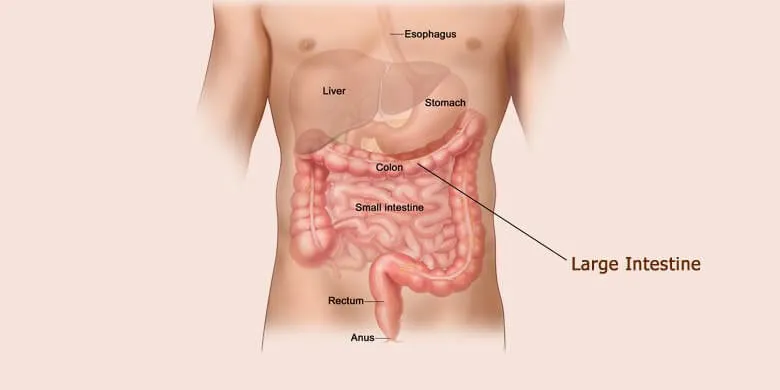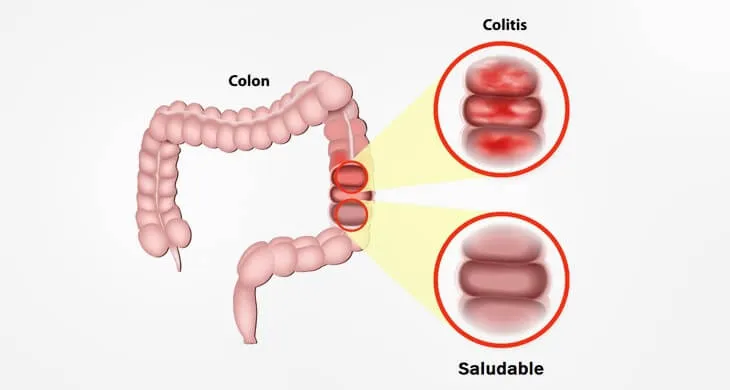The Large Intestine Definition, Facts and Information about Parts
Large Intestine Definition:
What is the large intestine definition? Last major segment of the digestive system consists of a long, winding and comparatively wide canal.
It performs the finishing task of gastrointestinal system responsibilities by absorbing the leftover fluids, salts and vitamins, etc. In biological terms, you call this organ the large intestine.
The Large Intestine Information:
Here you will find some precious large intestine information that will prove to be very beneficial for you.
The large bowel joins the posterior end of small intestine at caecum and runs in the same direction to reach rectum.
You can view its placement in the abdomen in the large intestine diagram.
At this point, it opens out of the body through anus. Assistance in defecation is an important anus function.
In case of bleeding in rectum or other parts of intestine, blood cells are also present in the feces.

The Large Intestine Parts
On the basis of spatial and functional distinction, colon consists of five different segments.
They are: ascending colon, transverse colon, descending colon, sigmoid colon and rectum. The cecal region marks the beginning of large bowel.
At this place, there is a finger-like, hollow tubular structure, namely, the appendix.
This structure of the excretory system is blind at the free end while the other end joins the canal through an opening.
It is thought to play a role in the immune system and circulatory system. However, there is no obvious digestive contribution of this body organ in human body.
Large Intestine Location:
The large bowel or colon is that part of the gastrointestinal tract which comes between the small intestine and the anal opening.
In other words, it starts from the terminal point of small intestine and ends at the anus. The colon is much wider than the small bowel.
And, it is this characteristic which gives it the name of large bowel. Looking like an upside down “U”, it lies in the lower region of the abdomen.
Large Intestine Function:
It is not just one large intestine function. There are many tasks that the last region of digestive tract has to perform. You can summarize them as follows:
Absorption
In the last part of the gastrointestinal tract, i.e. the large intestine, there is absorption of the leftover fluids.
At the same time, it also absorbs salts, mineral ions, and vitamins, etc. In this way, your body is able to retake the useful substances from the digestive waste.
Owing to its role in the absorption of fluids, the large bowel helps in the maintenance of the fluid content of your body.
In the individual, suffering from diarrhea, the bowel is unable to absorb the salts and fluids. So, there is the possibility of dehydration.
Feces Formation
The large bowel also assists in the conversion of indigestible material into feces for excretion through anal aperture. Anus definition reveals that it has ability to hold the feces back for some time. So, the individual gets time to reach toilet for defecation.
Habitation for Bacteria
The large bowel also provides a shelter and maintains the population of more than 500 bacterial species.
These bacterial species synthesize a number of useful products for human body. These are the good bacteria and do not cause any disease.
Just think, if such bacteria were absent, you would not get all these useful products.
Fermentation
This part of the gastrointestinal tract also carries out the fermentation of the waste and indigestible food.
The fermentation takes place with the help of bacterial action present therein. The fermentation of food in this part of the intestine results in the formation of short-chain fatty-acids.
At the same time, some gases are produced, including hydrogen, methane and carbon dioxide.
Feces Storage
Another important function of the large bowel is to serve as a storage for the waste material. After temporary storage, the undigested substances are emptied out of the body through anus.
While the digestive waste stays here, there is reabsorption of the useful substances, including salts, vitamins and minerals.
Excretion
Elimination of stool, that is indigestible part of dietary components, through anal opening. Here anal opening is the posterior most part of the digestive tract.
Do you know the major part of the food you eat is usually indigestible? So, you need to remove it out of the body. Otherwise, it will overstuff your body and you won’t be able to eat anymore.
The Large Intestine Diseases / Colonic Disorders
The large intestine information suggests that there are many types of colonic ailments. The colonic disorders may involve the symptoms, like large intestine pain.
Some of them may be benign, while others are chronic and may claim the life of the victim. However, many of such abnormalities are perfectly treatable by various means.
You can cure them through dietary measures, medications and surgical therapy. The major colonic conditions include IBS, UC and Colorectal Cancer.
The terms IBS and UC stand for Irritable Bowel Syndrome and Ulcerative Colitis, respectively. Diverticulitis, appendicitis and Colonic Polyps are some of other conditions of the bowel.
Appendicitis:
The appendicitis refers to an inflammatory condition. This inflammation occurs due to the trapping of food particles in the appendix.
There is possibility that the trapped food particles will lead to bursting of appendix. In case of pus formation, the only cure is to remove it surgically.
Colorectal Cancer:
Talking of the colorectal cancer, it is common among the individuals of over the age of 50. The risks of this cancer increase with age.
Also colorectal cancer is the fourth most common type of cancer among Americans.
Colonic polyps involve the growth of extra tissue in the lining of large bowel. This growth may become cancerous.
So, the doctors have to use surgical therapy to remove it out of the body.
Ulcerative Colitis:
The condition of ulcerative colitis is the condition of pain and bloody diarrhea. It refers to the ulcerous abnormality arising either in the colon or its rectal region.
The abnormality can occur at any time but usually starts at the age of 15 to 30 years.

Diverticulitis:
Diverticulitis involves infection or inflammatory disorder of pouches in the large intestine.
You can treat it through antibiotics, pain killer medications and liquid diet supplementation.
Irritable Bowel Syndrome:
Irritable bowel syndrome, as the very name indicates, causes irritation and difficulty in the passage of bowels.
Meanwhile, the patients experience abdominal pain, cramping and other symptoms. Supplemental diet, stress management and use of medications are very helpful.
However, you should apply them at the early developmental stages of the condition.
Interesting Large Intestine Facts:
Here are some interesting large intestine facts that will also contribute to your existing knowledge about this organ of the body.
- How long is the large intestine? Do you know that the large intestine is four times shorter than the small intestine? The small bowel measures up to 20 feet while the length of large bowel is only 5 feet!
- It is the action of smooth muscles in the (small and large) intestines that defies gravity. That is, it makes the food move in right direction even while you are doing headstand!
- These are the friendly bacteria that produce different gases in the large intestine.
- Are you aware of the fact that the gas, produced in the large bowel, has to perform an important function? It facilitates the absorption of vitamins and other nutrients which you can’t otherwise absorb.
- Your large bowel can store the digestive waste for up to two days!
- Do you know a person can live with the large intestine removed from their body? However, in the absence of this organ, the stool becomes really liquid. It seems as if the person is suffering from diarrhea.


